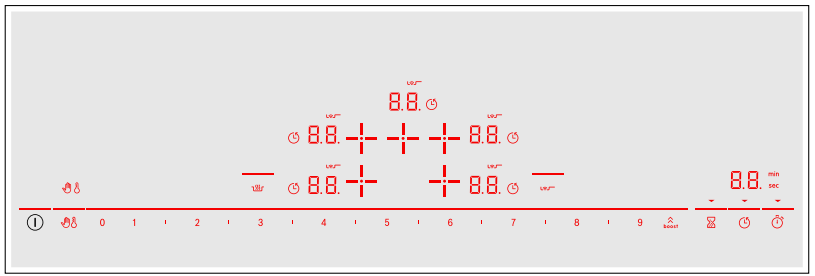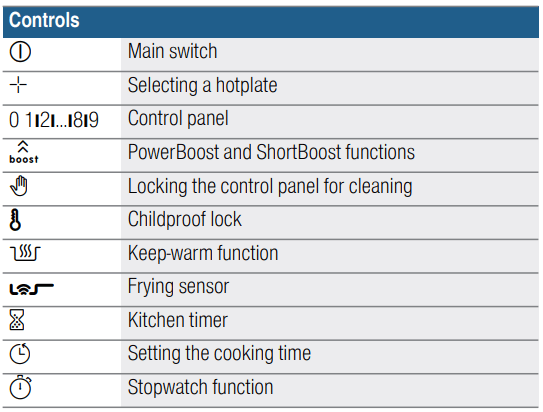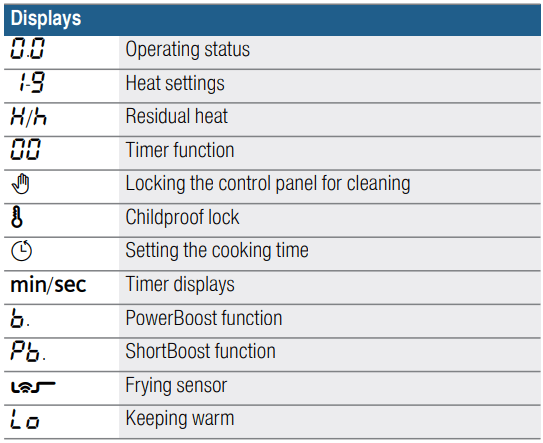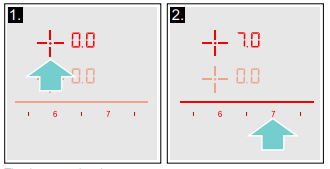Documents: Go to download!
- Owner's manual - (English)
- Induction cooking
- Getting to know your appliance
- Operating the appliance
- Cleaning
- Frequently Asked Questions (FAQ)
- Trouble shooting
Table of contents
User manual Induction Cooktop
Induction cooking
Advantages of induction cooking
Induction cooking is very different from traditional cooking methods, as heat builds up directly in the item of cookware. This offers numerous advantages:
- Saves time when boiling and frying.
- Saves energy.
- Easier to care for and clean. Spilled food does not burn on as quickly.
- Heat control and safety – the hob increases or decreases the heat supply as soon as the user changes the setting. The induction hotplate stops the heat supply as soon as the cookware is removed from the hotplate, without having to switch it off first.
Cookware
Only use ferromagnetic cookware for induction cooking, such as:
- Cookware made from enamelled steel
- Cookware made from cast iron
- Special induction-compatible cookware made from stainless steel.
To check whether your cookware is suitable for induction cooking, refer to the section on ~ "Cookware check".
To achieve a good cooking result, the ferromagnetic area on the base of the pan should match the size of the hotplate. If a hotplate does not detect an item of cookware, try placing it on another hotplate with a smaller diameter.

Some induction cookware does not have a fully ferromagnetic base:
- If the base of the cookware is only partially ferromagnetic, only the area that is ferromagnetic will heat up. This may mean that heat will not be distributed evenly. The non-ferromagnetic area may not heat up to a sufficient temperature for cooking.
-925278.png)
- The ferromagnetic area will also be reduced if the material from which the base of the cookware is made contains aluminium, for example. This may mean that the cookware will not become sufficiently hot or even that it will not be detected.
-383783.png)
Unsuitable pans
Never use diffuser hobs or pans made from:
- common thin steel
- glass
- earthenware
- copper
- aluminium
Properties of the base of the cookware
The material(s) from which the base of the cookware is made can affect the cooking result. Using pots and pans made from materials that distribute heat evenly through them, such as stainless-steel pans with a threelayer base, saves time and energy.
Use cookware with a flat base; if the base of the cookware is uneven, this may impair the heat supply.
-815550.png)
Absence of pan or unsuitable size
If no pan is placed on the selected hotplate, or if it is made of unsuitable material or is not the correct size, the power level displayed on the hotplate indicator will flash. Place a suitable pan on the hotplate to stop the flashing. If this takes more than 90 seconds, the hotplate will switch off automatically.
Empty pans or those with a thin base
Do not heat empty pans, nor use pans with a thin base. The hob is equipped with an internal safety system. However, an empty pan may heat up so quickly that the "automatic switch off" function may not have time to react and the pan may reach very high temperatures. The base of the pan could melt and damage the glass on the hob. In this case, do not touch the pan and switch the hotplate off. If it fails to work after it has cooled down, please contact the Technical Assistance Service.
Pan detection
Each hotplate has a lower limit for pan detection. This depends on the diameter of the ferromagnetic area of the cookware and the material from which its base is made. For this reason, you should always use the hotplate that best matches the diameter of the base of the pan.
Automatic detection in two-ring and three-ring hotplates
These hotplates can detect cookware of different sizes. Depending on the material and the properties of the cookware, the hotplate automatically activates the one-, two- or three-ring hotplate in order for the correct heat output to be supplied to achieve good cooking results.
Getting to know your appliance
You can find information on the dimensions and power of the hotplates in~ Page 2
Note: . Depending on the appliance model, individual details and colours may differ.
The control pane



Controls
When the hob heats up, the symbols for the controls available at this time light up.
Touching a symbol activates the respective function.
Notes
- The corresponding symbols for the controls light up depending on whether they are available. The displays for the hotplates or the selected functions get brighter.
- Always keep the control panel clean and dry. Moisture can prevent it from working properly.
- Do not place any cookware near the indicators or sensors. The electronics could overheat.
The hotplates

Residual heat indicator
The hob has a residual heat indicator for each hotplate.
This indicates that a hotplate is still hot. Do not touch a hotplate while the residual heat indicator is lit up.
The following indicators are shown depending on the amount of residual heat:
- Display H: High temperature
- Display h: Low temperature
If you remove the cookware from the hotplate during cooking, the residual heat indicator and the selected heat setting will flash alternately.
When the hotplate is switched off, the residual heat indicator will light up. Even after the hob has been switched off, the residual heat indicator will stay lit for as long as the hotplate is still warm.
Operating the appliance
This chapter explains how to set a hotplate. The table shows heat settings and cooking times for various meals.
Switching the hob on and off
The main switch is used to switch the hob on and off. To switch on: Touch the-808456.png) symbol. An audible signal sounds. The symbols for the hotplates and the functions available at this time light up. The 0:0 symbol lights up next to the hotplates. The hob is ready to use. To switch off: Touch the
symbol. An audible signal sounds. The symbols for the hotplates and the functions available at this time light up. The 0:0 symbol lights up next to the hotplates. The hob is ready to use. To switch off: Touch the -808456.png) symbol until the indicators go out. The residual heat indicator remains lit until the hotplates have cooled down sufficiently
symbol until the indicators go out. The residual heat indicator remains lit until the hotplates have cooled down sufficiently
Notes
- The hob switches off automatically if all hotplates have been switched off for more than 20 seconds.
- The selected settings are stored for four seconds after the hob has been switched off. If you switch it on again during this time, the hob will operate using the previously stored settings.
Setting a hotplate
Set the required heat setting using the 1 to 9 symbols.
Heat setting 1 = lowest setting.
Heat setting 9 = highest setting.
Every heat setting has an intermediate setting. This is marked in the control panel with the Ê symbol.
Notes
- To protect the fragile parts of your appliance from overheating and electrical overloading, the hob may temporarily reduce the power.
- In order to prevent the appliance from producing excess noise, the hob may temporarily reduce the power.
Selecting a hotplate and heat setting
The hob must be switched on.
- Touch the + symbol for the required hotplate. The 0:0 display gets brighter.
- Then select the required heat setting from the settings range.

The heat setting is set.
Changing the heat setting
Select the hotplate and then set the required heat setting in the control panel.
Switching off the hotplate
Select the hotplate and set it to 0:0 in the settings range. The hotplate switches itself off and the residual heat indicator appears.
Notes
- If no pan has been placed on the hotplate, the selected power level flashes. After a certain time has elapsed, the hotplate switches off.
- If a pan has been placed on the hotplate before switching on the hob, it will be detected within 20 seconds of pressing the main switch and the hotplate will be selected automatically. Once detected, select the power level within the next 20 seconds or the hotplate will switch off. If more than one pan is placed on the hob, only one will be detected when switching it on.
Chef's recommendations
Recommendations
- When heating up puree, cream soups and thick sauces, stir occasionally.
- Set heat setting 8 to 9 for preheating.
- When cooking with the lid on, turn the heat setting down as soon as steam escapes between the lid and the cookware. Steam does not need to escape for a good cooking result.
- After cooking, keep the lid on the cookware until you serve the food.
- To cook with the pressure cooker, observe the manufacturer's instructions.
- Do not cook food for too long, otherwise the nutrients will be lost. The kitchen clock can be used to set the optimum cooking time.
- For a more healthy cooking result, smoking oil should be avoided.
- To brown food, fry small portions in succession.
- Cookware may reach high temperatures while the food is cooking. We recommend that you use oven gloves.
- You can find recommendations for energy-efficient cooking in section ~ "Environmental protection"
Cleaning
Suitable maintenance and cleaning products can be purchased from the after-sales service or in our e-Shop.
Hob
Cleaning
Always clean the hob after cooking. This will prevent food deposits from becoming burned on. Only clean the hob after the residual heat indicator has gone out.
Clean the hob with a damp dish cloth and dry it with a cloth or towel to prevent limescale build-up.
Only use cleaning agents that are suitable for this type of hob. Observe the manufacturer's instructions on the product packaging.
Never use:
- Undiluted washing-up liquid
- Cleaning agents designed for dishwashers
- Abrasive cleaners
- Harsh cleaning agents, such as oven spray and limescale remover
- Scouring pads
- High-pressure cleaners or steam jet cleaners
Stubborn dirt is best removed with a glass scraper, available from retailers. Observe the manufacturer's instructions.
You can obtain a suitable glass scraper from customer services or through our online shop.
Using a special sponge for cleaning glass-ceramic hobs achieves a great cleaning result.
Potential marks
- Limescale and water marks
- Clean the hob as soon as it has cooled down. You can use a cleaning agent suitable for glass-ceramic hobs.*
- Sugar, rice starch or plastic
- Clean immediately. Use a glass scraper. Caution: Risk of burns.*
* Then clean with a damp dish cloth and dry with a cloth or towel.
Note: Do not use any cleaning agents while the hob is still hot. This may mark the surface. Make sure that any residue left by cleaning agents is removed.
Hob surround
To prevent damage to the hob surround, observe the following instructions:
- Only use warm soapy water
- Wash new dish cloths thoroughly before use.
- Do not use harsh or abrasive cleaning agents.
- Do not use a glass scraper or sharp objects.
Frequently Asked Questions (FAQ)
Using the appliance
Why can't I switch on the hob and why is the childproof lock symbol lit?
- The childproof lock is activated.
- You can find information on this function in the section on ~ "Childproof lock"
Why are the displays flashing and why can I hear an audible signal?
- Remove any liquid or food remains from the control panel. Remove any objects from the control panel.
- You can find instructions on how to deactivate the audible signal in the section on ~ "Basic settings"
Noises
Why I can hear noises while I'm cooking?
- Noises may be generated while using the hob depending on the base material of the cookware. These noises are a normal part of induction technology. They do not indicate a defect.
Possible noises:
- A low humming noise like the one a transformer makes:
- Occurs when cooking at a high heat setting. The noise disappears or becomes quieter when the heat setting is reduced.
- Low whistling noise:
- Occurs when the cookware is empty. This noise disappears when water or food is added to the cookware.
- Crackling:
- Occurs when using cookware made from different layers of material or when using cookware of different sizes and different materials at the same time. The loudness of the noise can vary depending on the quantity of food being cooked or the cooking method.
- High-pitched whistling noises:
- Can occur when two hotplates are used at the highest heat setting at the same time. The whistling noises disappear or become quieter when the heat setting is reduced.
- Fan noise:
- The hob is equipped with a fan that switches on automatically at high temperatures. The fan may continue to run even after you have switched off the hob if the temperature detected is still too high.
Cookware
Which types of cookware can be used with an induction hob?
- You can find information on which types of cookware can be used with an induction hob in the section on ~ "Induction cooking"
Why is the hotplate not heating up and why is the heat setting flashing?
- The hotplate on which the cookware is standing is not switched on.
- Check that you have switched on the correct hotplate.
- The cookware is too small for the hotplate that is switched on or it is not suitable for induction cooking.
- You can find information on the type, size and positioning of the cookware in the section on ~ "Induction cooking"
Why is it taking so long for the cookware to heat up or why is it not heating up sufficiently despite being on a high heat setting?
- The cookware is too small for the hotplate that is switched on or it is not suitable for induction cooking.
- You can find information on the type, size and positioning of the cookware in the section on ~ "Induction cooking"
How do you switch on two-ring and three-ring hotplates?
- These hotplates can detect cookware of different sizes. Depending on the material and the properties of the cookware, the hotplate automatically activates the one-, two- or three-ring hotplate in order for the appropriate heat output to be supplied to achieve good cooking results.
- Cookware that corresponds to the size of the hotplate as closely as possible and has a fully ferromagnetic base is most suitable. You can find information on which types of cookware can be used with an induction hob in the section on ~ "Induction cooking"
Cleaning
How do I clean the hob?
- Using a special glass-ceramic cleaning agent produces the best results. We advise against using harsh or abrasive cleaning agents, dishwater detergent (concentrated) or scouring pads. You can find more information on cleaning and caring for your hob in the section on ~ "Cleaning"
Trouble shooting
Usually, faults are small matters that are easy to eliminate. Please read the information in the table before calling the after-sales service.
| Display | Possible cause | Solution |
| None |
The power supply has been disconnected. The device has not been connected in accordance with the circuit diagram. Electronics fault. |
Use other electrical devices to check whether a short-circuit has occurred in the power supply. Ensure that the device has been connected in accordance with the circuit diagram. If the fault cannot be eliminated, inform the technical after-sales service. |
| The displays flash | The control panel is damp or an object is covering it | . Dry the control panel or remove the object |
| The - indicator flashes in the hotplate displays | A fault has occurred in the electronics. | To acknowledge the fault, cover the control panel with your hand. |
|
F2 F4 |
The electronics have overheated and have switched off the corresponding hotplate. The electronics have overheated and have switched off all hotplates. |
Wait until the electronics have cooled down sufficiently. Then touch any symbol on the hob. ”… |
| F5+heat setting and acoustic signal | There is a hot pan in the area of the control panel. There is a risk that the electronics will overheat. | Remove the pan. The fault display goes out shortly afterwards. You can continue to cook. |
| F5 and acoustic signal | There is a hot pan in the area of the control panel. To protect the electronics, the hotplate has been switched off. | Remove the pan. Wait for a few seconds. Touch any control. If the fault display goes out, you can continue to cook. |
| F1/F6 | The hotplate has overheated and switched itself off to protect the work surface. | Wait until the electronics have cooled down sufficiently and switch the hotplate on again. |
| F8 | The hotplate was operating for an extended period without interruption. | The automatic safety switch-off function has been activated. See section |
|
E9000 E90 |
The supply voltage is faulty; outside of the normal operating range. | Contact your electricity provider. |
| U400 | The hob is not connected properly | Disconnect the hob from the power supply. Ensure that it has been connected in accordance with the circuit diagram. |
| dE | The demo mode is activated | Disconnect the hob from the power supply. Wait 30 seconds and reconnect it. Touch any touch control in the next three minutes. The demo mode is deactivated. |
Do not place hot pans on the control panel.
Notes
- If E appears on the display, press and hold the button for the relevant cooking zone in order to read the fault code.
- If the fault code is not listed in the table, disconnect the hob from the mains power supply and wait 30 seconds before reconnecting it. If this code is displayed again, contact the technical after-sales service and specify which fault code has appeared.
- If a fault occurs, the appliance will not switch to standby mode.
See other models: PIV995DC1E PXE875DC1E PXV975DC1E CMG633BS1B CMG656RS1A
